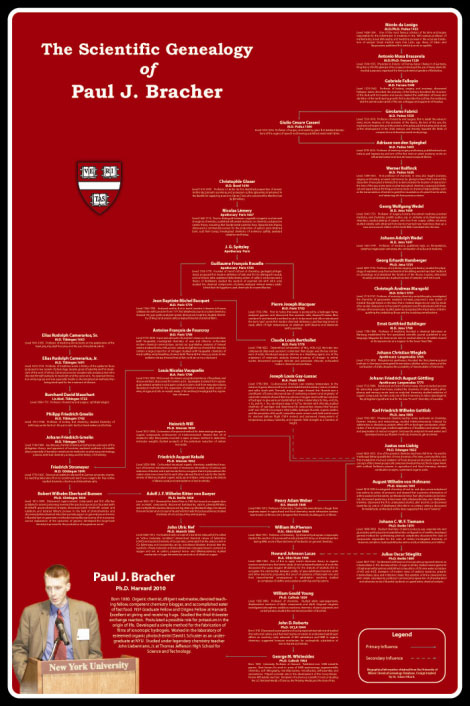
One thing that appeals to me about academic chemistry is its history. Unlike in industry, where businesses tend to come and go, most universities have been around for ages. When you enroll at a school to earn a degree, you instantly become part of a rich tradition of scientific apprenticeship.
In most college chemistry classes, lectures are sprinkled with historical tidbits, and you get to hear stories about various scientific characters and how they made their discoveries. During one such tangent in an organic chemistry lecture at NYU, I recall my professor (Yorke Rhodes) talking about the concept of having a "chemical family tree" where your doctoral advisor(s) equate to your chemical parent(s). With the help of the Internet and inspiration from a colleague in grad school, I made a poster of my chemical family tree earlier this year:

Before going any further, I must give credit where credit is due. First, the inspiration for this poster came from Adam Urbach. As a postdoc in the Whitesides Lab at Harvard, he came up with the idea of giving a scientific family tree to our boss and designed it from scratch. Adam's effort was especially convenient, because that family tree was of my "chemical father," so I could just tack myself on at the end. With some minor alterations, I retained Adam's basic layout. Like Adam, I also used the biographical sketches from the fantastic UIUC Chemical Genealogy Database maintained by Vera Mainz and Gregory Girolami. Aside from some minor editing, my main tasks involved spicing things up in Adobe Illustrator and Photoshop.
Actually, my family tree was essentially a recycling project. Almost all of the time I invested in the effort came in 2005, when I made this poster (PDF) for David Schuster's 70th Birthday Extravaganza. Since he and I share a common "ancestor" in his Ph.D. advisor, Jack Roberts, my chart didn't exactly require my restarting from square one.
So, what are the highlights? All sorts of exciting stuff...A Nobel Prize winner in Adolf von Baeyer; Joseph Gay-Lussac, famous for his work with gases; the great Justus von Liebig; and the guy for whom the Fallopian tubes are named. With hard work, dedication, and a little bit of luck, maybe one day I can have a part of the human reproductive anatomy named after me.